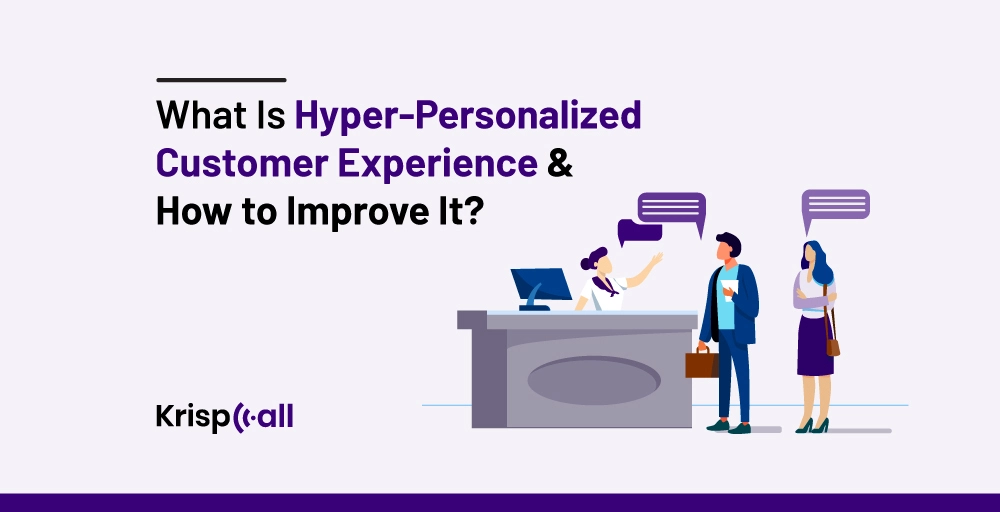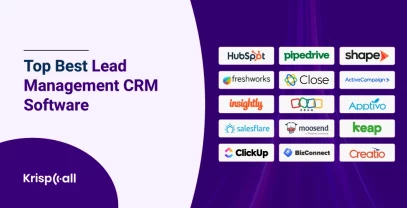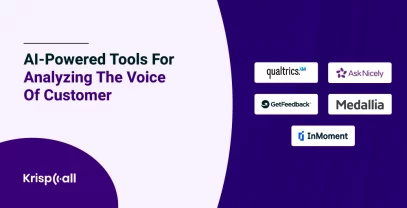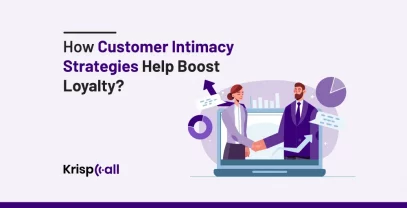In today’s ruthless competition and market trends, addressing customers’ names and general details is insufficient; you must dive 🌊deep into their world.
For knowing every customer’s preferences and needs, hyper-personalization is a 🕹️game-changing decision for any business. In today’s high customer expectations and demand landscape, hyper-personalization has become the ultimate unspoken key for companies.
In this blog, we will discuss the ✔️benefits and ⚔️challenges of a hyper-personalized customer experience and the differences between personalization and hyper-personalization.
🔑KEY HIGHLIGHTS
- Hyper-personalized customer experience tailors understanding customer preferences without them uttering a word.
- Personalization only focuses on customer general details, while hyper-personalization focuses on customers’ choices and needs along with general details.
- Advanced chatbots and virtual assistants are upcoming AI tools in hyper-personalized customer experiences.
- Generative AI complications, risk of over-personalization, and data privacy are some challenges that may arise during hyper-personalization.
What Is Hyper-Personalized Customer Experience?
Hyper-personalized customer experience is the process of marketing and promoting products and services to each customer individually at an immense level. Similarly, hyper-personalization in customer service ensures every customer’s needs are fulfilled.
In real-time, hyper-personalization uses artificial intelligence(AI), machine learning, and advanced data analytics to collect information about the customer and analyze it thoroughly to enhance the customer experience and deliver appropriate content.
Moreover, Amazon, Spotify, Stitchfix, Netflix, and Sephora are some companies that use hyper-personalization for better customer service and experience. These companies use AI and machine learning to analyze their customers’ likings and recommendations without asking them.
For instance, streaming platforms like Netflix and Spotify suggest and recommend its users movies, shows, or music based on users’ viewing or listening habits. This impresses users and hence enhances the customer experience.
What Does Hyper-Personalization Look Like?
Hyper-personalization seems far better than traditional personalization strategies. It benefits customers across different industries, changing their experiences by fitting into each customer’s likes and dislikes.
Every interaction with a customer is real-time, and customers will feel valued simultaneously due to the hyper-personalized customer experience. Here are some of the key aspects of what hyper-personalization looks like:
1. Data-Driven Vision
Hyper-personalization uses real-time customer data, data analytics techniques, and artificial intelligence to create highly customized customer integration and experience.
Data-driven insights have every detail about the customer and their likes and do.
Therefore, customers will feel valued and thrilled with the company for knowing everything about them. On the other hand, your company can suggest other products that meet their needs without them asking.
2. Personalized Email Marketing
Hyper-personalized email marketing customizes each message according to an individual’s needs, behaviors, and habits. Similarly, companies like Amazon leverage advanced data analytics and machine learning to analyze users’ product choices.
After analyzing customers’ preferences, they craft email campaigns to deliver their preferred products. These emails build strong customer relationships and brand loyalty by utilizing the power and benefits of hyper-personalization.
3. Unique Experiences
Hyper-personalization builds on the personalization process by interacting with each customer uniquely, thereby shaping individual digital experiences. Every interaction with customers is unique so they will have unique experiences with the company.
For example, Spotify uses data analytics to personalize content such as videos, channels, and music that resonates with each user’s taste. Hyper-personalization ensures that customer’s interactions with the company are relevant but also timely and informal.
4. Clear Objectives
Companies should have clear objectives for optimizing the hyper-personalized customer experience. Hyper-personalization is guided by clearly defined objectives that facilitate achieving specified goals.
Furthermore, hyper-personalization initiates clear objectives for deepening the relationship between the customer and the company. Objectives like improving conversion rates help businesses achieve tangible growth measures.
5. Quality Data Management
Hyper-personalization manages quality data, ensuring data accuracy and completeness. This process builds an understanding of customers’ choices and behaviors, enhancing effective customization.
The quality data management process helps businesses derive actionable perceptions that enhance personalization. If the data quality is better and more accurate, it increases customer satisfaction and loyalty.
How Hyper-Personalization Works?
Hyper-personalization works initially by collecting customer data from various sources, such as website visits, purchase history, and social media activity logs. Users browse their needs on the websites, and the hyper-personalization technique used by the companies analyzes those data in the customer’s favor.
The analyzation technique uses artificial intelligence (AI) and machine learning (ML). AI automatically recognizes every customer’s preferences and choices. Likewise, machine learning understands each customer in-depth, making predictions more accurate.
Similarly, after the analysis process, the next step is real-time adaptation. After understanding customers’ pain points from the data analysis, companies can interact with customers in several ways, such as personalized product recommendations or advertisements.
Hence, these interactions are integrated with various channels, providing guided customer experiences. The customer can interact with the company by using a mobile app or visiting a physical store, and the quality of customer service will not be deemed.
How To Hyper-Personalize A Customer Experience?
You must leverage advanced data analytics and technology to hyper-personalize a customer experience. Every interaction with the customer, according to their preferences, needs, and behaviors, is important, so hyper-personalization should be implemented.

1. Collect The Appropriate Data Across Channels
Collecting the appropriate data across channels involves analyzing detailed information about customer interactions and activities from various online locations. This involves online operands such as websites, mobile applications, social media, and other non-online operands.
Furthermore, this method allows businesses to gain enough information about their customers and how they will likely respond. Hence, collecting data across multiple channels helps formulate better approaches for satisfying customers in the future and smoothing customer experience.
2. Interpret The Data Within Its Context.
Interpreting data within its context involves processing and analyzing the information gathered to understand and deliver personal experiences related to various customer contacts. Data interpretation enables firms to understand the customer’s behavior better.
Likewise, better and more coherent decisions are made when you deeply understand the customers. Knowing the environment in which a customer encounters a brand can assist in customizing the delivered content, making the engagement more satisfying.
3. Personalize, Prompt, And Develop Content.
Personalization, prompting, and content development require selecting and producing content relevant to the customer’s interests. This may involve considering a group of customers within a particular industry and providing content that will appeal to them.
Moreover, dynamic and adaptive content creation increases customers’ attention to the provided content and guarantees a higher customer satisfaction rate. Hyper-personalized customer experience takes this step forward by developing content according to customers’ preferences.
4. Optimize Visibility And Engagement.
The content should be seen by users, as it is worthless if no one sees it. Similarly, many businesses don’t know clearly whether their content was delivered and seen. Optimizing visibility and engagement is necessary to make intelligent decisions.
Optimizing and tracking when, what, and where your content was delivered is essential for any business to grow. Moreover, promoting interaction with customers through more content, offers with a flavor of customers, increasing visibility and customer participation.
5. Learn And Improve
An effectively implemented hyper-personalization is a process of ongoing learning and adaptation that gathers valuable insights from customers’ behavior and responses. Businesses need to analyze every customer’s actions and feedback constantly.
Experimenting and testing, such as A/B testing, enables companies to assess the suitability of applying specific personalization strategies. Deploying these tests within hyper-personalized customer experiences means implementing them to promote the best, most precise experience for clients.
Hyper-Personalization Vs. Personalization: What are the Differences?
Personalization is providing better customer service based on customers’ preferences, behavior, and needs. In this process, online businesses look at customers’ recent purchases and suggest products based on that data.
Meanwhile, hyper-personalization is the updated version of personalization. This marketing strategy leverages real-time data and provides a better customer experience. Its main feature is providing a more customized experience for individual customers.
Some key differences between personalization and hyper-personalization are:
| Aspect | Personalization | Hyper-personalization |
| Data Usage | It relies on basic information, such as name, gender, and location. | It accesses real-time data of every individual customer to enhance customer experience. |
| Customization Depth | Surface-level customization | Immense deep-level customization. |
| Technologies Usage | Basic data analytics and segmentation tools | Artificial Intelligence, Machine learning, and advanced data analytics tools. |
| Customer Satisfaction | Improves customer satisfaction by addressing general needs. | Improves customer satisfaction by meeting specific needs. |
| Complexity and Scalability | Easy to implement and scalable to meet customers’ needs. | More advanced data is required to handle the complexity of individuals. |
Benefits Of Hyper-Personalization: How Hyper-Personalization Improves Customer Experience?
Hyper-personalization benefits and improves customer experience in many ways. Hyper personalized customer experience means every individual customer is delivered highly relevant and real-time content. This process enhances customer engagement and satisfaction.
Hyper-personalization fosters strong emotional connections with customers and maintains customer relationships. This personalized strategy boosts conversation rates and smoothens customer loyalty toward the company.
Some benefits of hyper-personalization are:
- Increased Relevance: Hyper-personalization boosts interactions with each customer and their unique preferences and behaviors. This assures that the content and marketing messages are highly relevant and increase relevancy.
- Enhanced Customer Engagement: Hyper-personalization enhances customer engagement by offering personalized experiences in real-time with every customer. Customers will also be fascinated if their choices and interests are respected and valued.
- Higher Conversion Rates: Conversation rates are increased because of hyper-personalization as it presents and projects the right products to customers at an appropriate time.
- Improved Customer Loyalty: When customers feel valued, and their needs and preferences are fulfilled, their loyalty to a brand increases. Hyper-personalization helps deepen strong emotional connections with customers.
- Better Customer Retention: Hyper-personalization provides relevant and accurate data. This process reduces customer churn and focuses on improving customer retention.
- Enhanced Customer Satisfaction: Hyper-personalized customer experience provides better services, automatically enhancing customer satisfaction and boosting Customer Satisfaction Score (CSAT). Satisfied customers are the main pillar of business growth.
What Are The Challenges Of Hyper-Personalization?
Hyper-personalization has both benefits and challenges. Therefore, challenges may arise when implementing hyper-personalized customer experience in any business. They need to be tackled as soon as possible for better customer experience.
Here are some challenges of hyper-personalization:
- Generative AI complications: Hyper-personalization uses generative AI power to hyper-personalize customer experience. This process adds a layer of complexity and challenges, and sales professionals without technical knowledge will face this problem more.
- Data Privacy and Security Concerns: Hyper-personalization means collecting and analyzing customer data at an immense level. So, managing and protecting data to comply with privacy regulations can be challenging.
- Risk of over-personalization: There should be a fine line between personalization and over-personalization. Hyper-personalization may sometimes risk over-personalization by providing precise content that irritates users.
- Resources-Intensive: Hyper-personalization requires advanced technologies to process customer data. Small businesses with limited resources can’t invest more in these technologies, so they face resource-intensive challenges when implementing hyper-personalization.
- Scalability Issues: These issues arise when the business expands hyper-personalization efforts to increase customer data volumes. Larger audiences need high-quality personalization, straining the current system. Upgrading hyper-personalization is not an easy task, though.
How Much Does Hyper-Personalization Cost?
Hyper-personalization costs vary according to the sizes and resources of the businesses. Some important points to consider when understanding the pricing of hyper-personalization when used in businesses are as follows:
The cost of the hyper-personalization as per its dependency on:
- Extensive AI technologies: Depending on the business’s requirements, customized and extensive AI can cost from $6,000 to $300,000. In addition, the cost of training AI models ranges from $8,999 to $14,999. It’s expensive, though large companies with larger teams can adopt this technology.
- Pricing for hyper-personalization platforms: Hyperise is a Hyper-Personalization Platform. Their packages are Agency $99/month seat; 5 seats included. Extra can acquire more seats for $75 for each extra seat.
- Costs for small businesses: Because of resource constraints, smaller companies may not be able to implement advanced hyper-personalization technologies. However, creating individualized product recommendations requires investing in data analysis tools, costing $50 to $500. Email marketing software costs from $10 to $300 per month.
Future Of Hyper-Personalized Customer Experience And The Role Of AI
Hyper-personalized customer experience has a solid future and will be revolutionized by AI and machine learning. Real-time personalization and omnichannel customer experience will be among those trends that will help customers achieve highly personalized experiences during interaction.

New and emerging technologies like advanced data analytics, Augmented Reality (AR), Virtual Reality (VR), and 5G connection are taking hyper-personalization to another level. These technologies allow businesses to deliver quality content, assuring the engagement of each customer interaction.
Furthermore, hyper-personalization will persist by leveraging artificial intelligence and machine learning algorithms to identify client behavior patterns. This has further highlighted the need to integrate NLP technology to improve machine understanding of customer intent.
Moreover, future trends in utilizing AI technology in customer interaction will include better customer diagnosis through improved chatbots and virtual assistants. Real-time data management for all channels will help companies see all the necessary customer information.
Also, predictive analytics and AI in the content-creating tool will guarantee that customers are presented with relevant and timely content, deepening the brand’s bond. Advanced chatbots and virtual assistants are upcoming AI tools in hyper-personalized customer experiences.
Advanced chatbots provide simple and personalized assistance to deliver engaging experiences and deeply learn about users’ needs. On the other hand, virtual assistants help customers find relevant products and make purchases in real-time.
Conclusion
Today, customer interactions are not just a necessity of business but also the key to its success, so hyper-personalization has become more than an innovation. The opportunity to use artificial intelligence and real-time data makes customers’ experiences special.
Therefore, it is necessary to take hyper-personalization to a new level to unlock the possibilities of customer satisfaction and loyalty throughout the entire customer journey in the digital world. A hyper-personalized customer experience is not just an option; it’s a necessity.





